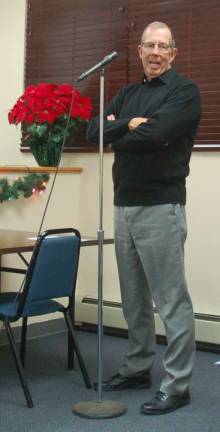Engineers say Sussex Borough's water safe

SUSSEX BOROUGH — Gerry Gardener and James Schappell of Houser Engineering were in attendance to tell borough residents about the water is safe.
Trihalomethanes, aka THMs, are chemical pollutants that commonly form as a result of chlorine being mixed with substances in water such as decay or any other organic matter. Chlorine is added to the water at the water plant as a disinfectant.
“There is a state standard for 80 parts per billion," Gardener said. "The rolling average for the borough exceeded 80 approximately a year and a half ago.”
Gardener used baseball as an analogy to explain why the rolling average is not below 80.
“If a hitter is hitting .250 through the first five months of the season and then suddenly goes on a tear the last two weeks and hits .300, his average just goes up a little,” he said.
He says the same thing is happening with the borough’s THM rolling average level.
“We might have had a high THM level two or three years ago, and now we’ve got it low but it’s going to take quite a while to get the rolling average down,” Gardener said.
As of now the level is in the 60s and 70s because of the cold weather and lack of organic growth.
One resident asked if the water is hazardous to drink, cook with, and shower with at the present time.
“It’s absolutely safe," Schappel said. "THM’s are not an immediate hazard, it’s really long term.”
The resident then made the argument, “You’re saying long term but it has been long term already.”
“Long term meaning 75-90 years, so lifetime exposure, and to much higher levels," Gardener said. "And even then the risk is very small.”
Schappell said they looked at the data from the DEP and there hasn't been a violation since 2004.
The borough has two options to end this issue.
Either build a pipeline directly from Lake Rutherford to the water plant, or expand the water plant in order to make sufficient engineering changes to treat turbidity. Turbidity is the cloudiness of water caused by heavy storms or water picking up dirty matter as it flows.
Gardener said that expanding the water plant would also involve rebuilding Colesville Reservoir, which would require a lot of additional costs.
“That Colesville Reservoir is a mess," he said. "It would be quite a job to rehabilitate that reservoir and expand the plant. Building the pipeline would be the cheapest, most cost-effective long term solution.”
However, designing and construction of the pipeline is being delayed because there are some problems with acquiring the rights to use strips of land.
“It would cross two properties," Gardener said. "High Point State Park and privately owned land that has been leased back to the state as an agricultural easement.”
Gardener clarified how the borough currently gets its water.
“Lake Rutherford is our water supply. We own the lake and a strip of land around the lake. The water overflows the damn and flows through the woods 5/8th of a mile down to Colesville Reservoir, which is where the treatment plant is. That open channel that the water flows down is not ours.”
Gardener was arguing to the state that the channel the water currently flows down can be completely destroyed in a big storm and the water could be redirected away from Colesville, and they would have no control over it.
That open channel is where a lot of the silt, dead leaves and other organic matter is picked up and comes into the plant, which is what mixes with chlorine to create THM’s. Much of the matter is also picked up at Colesville. The pipe would bypass all of that and take the water directly from Lake Rutherford.
In the meantime, there are some fixes that are being made to lower the rolling average of THM levels.
As of now they chlorinate the water twice, when it enters the plant before it reaches the filters and then a second time after filtration.
In the beginning as the water enters the plant, the THM’s are generated when the matter in the water is mixed with chlorine, so they will move the chlorination process down the line after the filtration process.
“If we don’t pre-chlorinate and put some other chemical to kill the bacteria coming into the plant, we won’t generate the THM’s immediately. It’s a pretty easy fix so we’re going to make that switch.”
He said that they will stop pre-chlorination within 30 days.
“The quality of the water doesn’t lower because we’ve moved the chlorine down stream," Gardener said. "As long as we have enough contact time to kill everything, which we do.”
Another thing Gardener said they would do is close the loops.
“The water just goes over to the lake and stays in the pipelines there until it’s used, it doesn’t travel back," he said. "Originally the design calls for a loop in that the Loomis Ave. bridge has a pipe that crosses back so the water goes in both directions, and no THM’s generated.”
That pipe was broken during Hurricane Irene and has not been repaired yet, so that is something they will be fixing.\
During the winter months they won’t be able to see if the rolling average of THM’s has lowered because the levels are already low due to the cold weather. It won’t be until the consistently warmer weather around June where they will be able to see if these changes did anything.